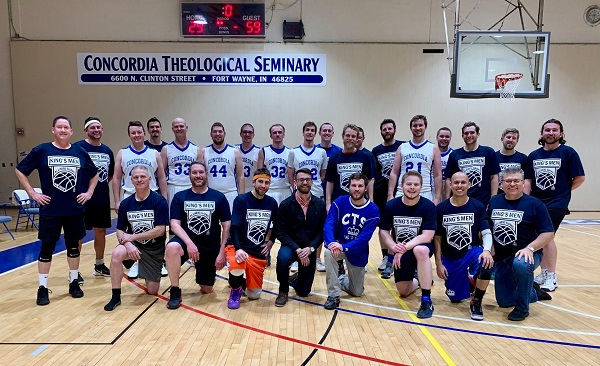Here are the Exegetical Symposia Paper Abstracts, for the short sectional papers that were presented this morning. If you would like a copy, we recommend contacting these pastors and presenters directly. You should be able to find their contact info through the LCMS locator on the main Synod website.
Also, this picture is from the Alumni King’s Men game last night. It’s safe to assume that the King’s Men won, though we make no conjectures about whether the young guys or old guys were the official winners (ignoring the fact that some of these “old guys” were in classes with the “young guys” only last year).

The Typological Christology of the Burnt Offering in Ancient Israel’s Daily Divine Service
Rev. Dr. Robert D. Macina, Risen Christ Lutheran Church, Arvada, CO
YHWH instituted the daily divine service with all of its ritual activities so that he could dwell among the Israelites at his sanctuary. One main part of this service involved the high priest conducting his ministry by wearing his ornate vestments at the altar for burnt offering in the courtyard of the tabernacle. Based on the ritual legislation in the Pentateuch, this sectional analyzes what God achieved through the high priest’s enactment of the burning rite in ancient Israel’s daily divine service and its fulfillment in Christ.
A More Contextual Look at Papias’ Fragment Regarding Matthew and One Possibility of a Hebrew ‘Style’ (Dialektos) for that Gospel Account
Rev. Paul Landgraf, St. John’s Lutheran Church, Owensville, MO
Papias’ words regarding Matthew are usually understood to mean that the Gospel according to Matthew was originally written in the Hebrew language. This paper will support the minority view espoused by some (e.g., Kürzinger) that Matthew wrote in a Hebrew style and will offer one possibility of how that may have been understood. In short, a portion of the literary structure of Matthew’s five discourses (Sermon on the Mount, etc.) will be compared to that of the Pentateuch.
Isaiah 5 and the Eschotological Vineyard
Rev. Jacob Hercamp, STM, St. Peter Lutheran Church, La Grange, MO
The word כֶרֶם and its derivatives appear 92 times in the bible, with 11 of those occurrences falling within the book of Isaiah. The image of the vineyard is one of the images depicting the eschatological restoration spoken of throughout the Old Testament beginning with Noah (Gen 9:20; also see Isaiah, 27:2, 36:17, 37:30, 65:21). In Isaiah 5 YHWH uses the image to describe how He had cultivated a new one, a vineyard that held great promise. However, as we read the song of the vineyard, we learn that the fruit of the vineyard is poor and judged accordingly. With this in mind, what eschatological implications are at play? In this paper, I will examine Isaiah 5 and the image of the vineyard in the context the eschatological vineyard elsewhere in Isaiah and the greater canon of Scripture to shed further light on this rich theological image.
An Assessment of Martin Luther’s translation of Colossians 2:16 and its reception
Rev. Dr. Jacob Corzine, Assistant Professor of Theology at Concordia University Chicago
It’s well known that Martin Luther’s translation of the bible takes certain freedoms for the sake of clarity. Interesting is when these freedoms are picked up in the Lutheran Confessions or other prominent places, or when they represent particular dogmatic-theological judgments. Such is the case in Colossians 2:16, where Luther translates the greek word krino with a reference to conscience instead of simply with the available German terms for judgment. Since this is taken up some German texts of AC 28, the matter is of confessional relevance. This paper will review related passages in Luther’s translation as well as the multiple layers or revision of Luther’s translation which, as they are peeled back, confirm something of his original intention as he himself documented it.
Teaching Koine Greek as a Living Language
Dr. David Maxwell, Professor of Systematic Theology at Concordia Seminary St. Louis
What if you could think in and speak koine Greek? In the last generation or so, professors in the field of Classics have begun to teach Latin and Greek as living languages. This presentation makes the case for that approach and demonstrates what the pedagogy might look like. Finally, a short lecture on the prologue of John will be delivered in Greek to prove that this is actually possible.
Biblical Communion, Pastoral Stewardship, and God’s Judgment: 1 Corinthians 11:27-32
Rev. Daniel Merz, The Lutheran Church of Our Savior, Stanhope, NJ
The pastor has the awesome task of administering the body and blood of Jesus to his church. This is a fearsome undertaking even in the most ideal setting. One problem facing the modern Lutheran pastor is the general sense of apathy regarding all things sacred. Nowhere is this felt more acutely than when the faithful pastor must turn someone away from the Lord’s Table. The pastor may have just saved the smoldering wick of the would-be communicant’s faith, but his act of pastoral integrity and biblical love is often decried as, “unloving and unwelcoming, does it really matter? Isn’t it just between Jesus and me? Who is the pastor to judge hearts?”
All who receive the bread and wine during the Sacrament of the Altar receive Jesus; but to their blessing or to their judgment? The faithful pastor cannot force someone to believe and receive the fruit of the cross to their blessing, but he can and must protect all those who come to the altar which has been entrusted to his care. It is his job and his burden, and it is not easy, but for the wellbeing and blessing of all, he does it faithfully. The pastor administers the Lord’s body and blood in accordance with the revealed word of God, and by his actions, it is made known what he believes about the power of Christ’s real presence and how that belief manifests itself in his pastoral care and stewardship of the altar.
The Vengeance of God as Atoned Wrath in The Song of Moses in Deuteronomy 32
Rev. Jacob Eichers, STM, Faith Lutheran Church, La Crosse, WI
The idea of God as a vengeful, vindictive god has fallen out of vogue in modern theological circles. Anything that smacks of the wrath or violence of God is swept under the rug because God is love, not hatred. The Song of Moses in Deuteronomy 32 is one such passage wherein the vengeance and violence of the Lord is described. The root נקם (nun-qof-mem) [vengeance] appears three times in Deuteronomy 32, and a proper understanding of this word will help shed light on the relationship between the Father’s wrath and the salvation of His people. God’s vengeance (נקם) is not aimless violence. It is not “divine child abuse.” God’s vengeance (נקם) is a perfect God using wrath to atone for sin and to restore the faithful.
Adequate Ransom: Chemnitz, the “Genus Apotelesmaticum,” and the Necessity of Both Natures in the Atonement
Rev. Brandon W. Koble, Teaching Fellow at Marquette University
Martin Chemnitz is most known for his explication of the two natures within the one person of Christ. In his systematizing of early Lutheran Christology, Chemnitz articulates aspects of the atonement throughout his treatise The Two Natures of Christ. The relationship between Chemnitz’s Christology and his soteriology is summed up by Jack Kilcrease: “[T]he person of Christ is inexorably tied up with the work of Christ.” This paper will look at themes of the atonement that Chemnitz treats in The Two Natures of Christ, specifically it will seek to address in what way Chemnitz discusses the necessity of both natures in regards to the atonement. The cooperation of the natures is most evident in Chemnitz’s genus apotelematicum and thus, the focus will be on how the two natures work together to accomplish God’s soteriological plan. A secondary goal of the paper will be to see what specific aspects of the various theories of atonement theology Chemnitz brings out in his treatment, using Gustav Aulén’s Christus Victor for the three different models.
The Genealogical Interpretation of Scripture in 1 Clement
Daniel Broaddus, Ph.D. Student
1 Clement has largely been misunderstood by modern scholars with respect to Clement’s interpretation of the Old Testament. The recognition of extensive intertextuality in the epistle, however, opens up a number of possibilities for understanding a much deeper interpretation of the Old Testament by Clement. Such a recognition reveals that Clement understands the Old Testament testimony to be a present witness to the work that God does through Jesus Christ within his church. This work is primarily viewed through the lense of re-generation, especially as it can be seen in the Christian rite of baptism.
The purpose of this study is to highlight Clement’s genealogical vision for the church in Corinth through his use of the Old Testament Scriptures, particularly Genesis. It is apparent from the opening chapters of 1 Clement that he understands the book of Genesis to provide a fundamental genealogical vision for the Christian life that is then meant to inform Christian conduct towards each other and toward their leadership. Whereas this is only one aspect of Clement’s theology it plays a vital role in establishing the foundation upon which he will build in the rest of his epistle.
“Did God angrily crucify Jesus?” Yes, according to Thomas Aquinas
Troy Dahlke, teacher at St. Andrew’s Episcopal School
“Did God angrily crucify Jesus?” Perhaps surprisingly, Thomas Aquinas would answer “yes.” This paper circles the passion of Jesus Christ as Thomas sees in it the “once for all” figurative expression of the ira Dei. What Christ experienced in the place of sinners are the effects of the just and necessary consequences of sin. Such a claim, however, neither dialectically oppose the Father and the Son, nor does it threaten divine apatheia; as a figurative expression, iradoes not signify divine aseity. But it does, in the fullest sense, signify the severity and effects of sin as narrated in economy of salvation.
